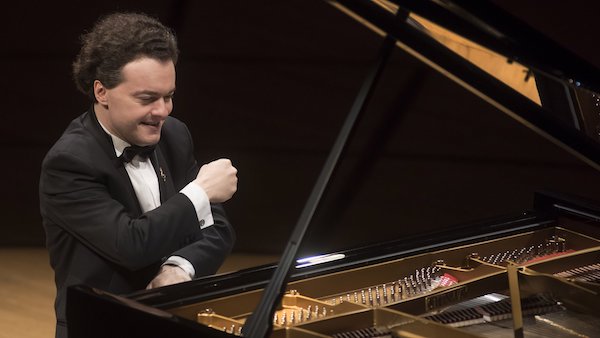Kissin brings glowing colors, demonic energy to Horowitzian program

Evgeny Kissin performed Thursday night at Carnegie Hall.
Like an energy-saving light bulb that takes a few minutes to come on all the way, Evgeny Kissin’s Carnegie Hall recital Thursday night began somewhat dimly, with the pianist stepping gingerly through three Chopin nocturnes. Brighter lights were soon to come.
Time was that most piano recitals started this way, with the artist playing something relatively simple, to get a feel for the keys and the room and the audience before launching into the big, challenging pieces that the customers paid to hear him conquer.
Chopin’s F minor Nocturne, Op. 55, no. 1, with its simple melody, walking bass and bit of drama in the middle, has been the “first nocturne” for many an intermediate-level piano student. (Kissin, the onetime child prodigy, probably learned it at age 3.) The pianist led off the evening with a straightforward performance of this familiar piece.
But the pot began to bubble in the rippling thirds and sixths of the G major Nocturne, Op. 37, no. 2, and Kissin’s large box of colors came out for the many modulations of its rocking second theme. Finally the E major, Op. 62, no. 2, a more complex piece from Chopin’s last period, emerged in all its multilayered glory, aching with nostalgia at the close.
Schumann’s Sonata No. 3 in F minor, Op. 14, originally conceived as a “concerto without orchestra” and published after many revisions as a “Grande Sonate,” is a work more admired than performed, owing to its fiendish technical demands and relative lack of catchy tunes. But on Thursday, Kissin had the goods to make it go.
The pianist brought all his considerable resources of color and touch to the multifarious first movement, a tumble of impetuous octaves, crisp leggiero chords, and dense imitative textures. Perhaps his greatest accomplishment was finding the through impulse that drove it all, so that arrival at the movement’s structural points paid off handsomely.
The scherzo seemed quite a bit faster than the marked “comodo” (comfortable) tempo—still comfortable for this wizardly pianist, maybe—as Kissin shook the music out of his fingers with sovereign ease. The rich-toned trio glowed with an orchestral palette evoking cellos, horns, and flutes.
The third movement, free variations on a simple descending theme by the composer’s love Clara Wieck, unfolded naturally, with new elements joining the party at each stage before winding down in a delicate diminuendo, the top voice singing to the pianissimo finish.
In the finale’s “Prestissimo possible” rush, surges and sprays of notes went everywhere, and crescendos came in sudden gusts. Rewarded at last with the elemental pianism many had likely come to hear, the audience stood and cheered the artist at the close.
The cannily planned program pressed the reset button after intermission, opening the second half with the most calm, stately music imaginable, Debussy’s “Danseuses de Delphes.” Seven more selections from Préludes, Books I and II, followed.
Kissin’s demonic, Lisztian energy was most welcome in “Ce qu’a vu le vent d’ouest” and the literal pyrotechnics of “Feux d’artifice,” but he didn’t fully set it aside for the whimsy of “La sérénade interrompue” and “General Lavine—eccentric.” “Les collines d’Anacapri” sounded a bit more like volcanoes than sunny hills, and “La fille aux cheveux de lin” sang her song more urgently than blissfully. But Kissin took his time in “La cathédrale engloutie,” as the bells tolled, the monks chanted, and the waves rolled magnificently.
Surely the marriage of the synesthetic composer Scriabin and the keyboard colorist Kissin was made in heaven. The former’s concise Sonata No. 4 in F-sharp major, Op. 30, opened with a gorgeous melody in the left hand under delicately chiming chords in the right; tone colors proliferated and blended, deepening the musical texture.
The stormy spirit of Schumann’s Prestissimo and Debussy’s “west wind” returned in Scriabin’s closing pages, blowing up a Lisztian grand passion amid surging repeated chords.
The audience’s rapturous and persistent applause managed to extract three encores from the pianist–actual “encores” in this case, bringing the evening’s composers back for another bow: Schumann’s “Traumerei,” Debussy’s “Golliwogg’s Cake-Walk,” and Chopin’s Valse brilliante in A-flat major, Op. 34, No. 1. This Horowitzian selection seemed to beg for Scriabin’s impassioned Etude in D-sharp minor to complete the circle, but that will have to wait for another night.